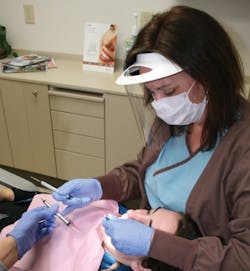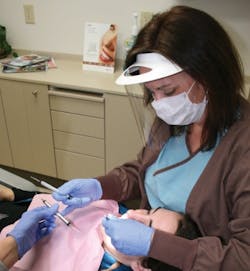Secrets to my success
By Hope Watson, DMD
For more on this topic, go to www.dentaleconomics.com and search using the following key words: secrets to my success, vision, patient education, Hope Watson, DMD.
"So, how many hygiene patients does your practice see in a day?" It's a question many of us ask each other in these tough economic times. Dentists understand that our return hygiene patients are the bread and butter of our practices. It's the area that fuels the engine of the practice. My answer to their question is, "Twenty-four to 30."
Yes, I have three full-time dental hygienists, and a great staff that is committed to keeping their schedule full. But with ever increasing layoffs and companies cutting dental insurance benefits, how do we keep our schedules full? We educate our patients about the importance of good oral health.
I was raised by an educator. My mom taught middle school and high school biology and anatomy for more than 30 years. I knew when I went off to college that I wanted to be anything but a teacher. People always joked about teachers' jobs being so easy - home by 4 p.m., summers off, no work during the holidays or school breaks.
But when you are raised by a teacher you know that nothing is further from the truth. Teachers are some of the hardest working people I know. A true teacher's work is never done. So when I was accepted to dental school, I thought, "Awesome! Finally the internal struggle is over! I am going to be a doctor!"
Well, the joke was on me. The very first day of dental school - in my very first class - on a hot July morning, my distinguished professor, a dentist, author, and very intimidating fellow, walked into the room. He plopped his textbook down on the podium, and announced, "The word doctor, in Latin, translates into teacher!" "WHAT?" I thought. "Are you kidding me? This is not what I signed up for!"
What I have learned over the past 13 years of owning my own practice is that he was exactly right. Every day I have the privilege of helping restore and preserve people's oral health.
This doesn't come from patients rushing through my door for anesthetic, fillings, crowns, or to have unsightly calculus removed from below their delicate gums, but rather from educating patients and forming trusting relationships with people so that I become not only their dentist, but their friend and liaison for great oral and overall health.
Success begins with education
When I hung out my shingle in 1998, it was just one dental assistant and me. I opened my practice in an area that, for its small size, was saturated by general dentists. Like any new dentist who was opening his or her practice, I knew that I would initially see a great number of emergency patients.
What I did not want was a reputation as a one-stop shop, a fix-it-and-forget-about-it dentist. So, as I greeted new patients, I tried to take care of their problems, but I also educated them about what else was going on in their mouths.
Educating patients about additional areas of concern proved to be a great thing on many fronts. Patients were grateful to have their initial concern addressed, but by taking the time to express my concern that other areas of their mouths may have issues, patients sensed that I cared, which I did, and that I did not want them to be in an emergent state again.
A level of trust began to be established. Before long, a number of the emergency patients became patients with comprehensive treatment plans.
I saw great returns by doing this same thing with nonemergent patients, as well. I still use simple analogies that patients can relate to to explain complex biological processes in the body. Sometimes my analogies are so silly that we all get a good laugh, but the message gets across and impacts patients' understanding and decision making in accepting my treatment plan.
Patients appreciate a sense of humor, and it's a fabulous way to shed the "white coat" and show patients that my role as a dentist is just a part of me as a person.
More seriously, I explain to patients what is occurring during the different steps of their exam and what they can expect to feel during each step. Explanations help alleviate their anxiety that "something may hurt," as well as educate them that coming to the dentist is about much more than getting their teeth cleaned. We all need to explain the process.
Doing so puts value on the fact that we are looking for things other than picket-fence pearly whites. Patients need to hear that we are searching for gum disease and oral cancer in addition to cavities, and I feel that this is the only thing many patients think we look for.
Patients need to understand that we also evaluate for extraoral changes that could save their lives. It's been me, not their primary care physicians, who noticed skin changes in multiple patients.
Two of these patients have been treated for melanoma, another for squamous cell carcinoma of the vermilion border, and several for basal cell carcinomas. Time spent educating patients is time well spent.
Explanations often spawn questions that not only lead to dialogue, but also help build trusting relationships with your patients. Incorporating technology into my practice has also been a great way to educate patients.
This is an area that I admittedly resisted for many years, but now that I have technology, I wish I had taken the plunge sooner.
Digital radiography and intraoral cameras are two of the best patient education tools we can have in our office. If you have trouble conveying to patients why a cracked tooth needs a crown, or why a failing restoration needs to be replaced, or why a tooth needs endodontic therapy, then you need these two tools in your practice. I know we hear this often, but I tell you, it is the absolute truth!
The magnified resolution of your findings will have patients asking you to work harder and faster to make their mouths healthy and beautiful. These awesome tools also help your staff demonstrate to patients what might be going on in their mouths and this leads to dialogues that make your educational role much easier.
So often now I walk in to see patients who already have a good idea of what the next step of their dental therapy will be because a staff member has shown them the problem and addressed their questions. The role of teacher also extends into my roles as owner of my company, senior dental partner, and manager of my staff. It is my vision that initiated this practice and drives the everyday operations of my company.
It is the ability to educate my team about this vision that unifies us, helps us translate complex ideas and treatment plans, and helps patients experience a smooth, repeatable, positive process.
Developing company lesson plans ensures simple and repeatable tasks are followed through so that patients receive complete care from the time they enter our office, through referral to specialists, until they are healthy patients coming for regular visits.
Becoming a teacher within your practice will be a beneficial experience for everyone. It may force you into an area you may not be comfortable with, but you will learn some valuable lessons.
Hope Watson, DMD, has been in private practice in Maryville, Tenn., since she graduated in 1997 from the University of Alabama School of Dentistry. She is an active member of the ADA and currently serves as vice president for the Tennessee Dental Association's Second District. She has been married to Bob for 19 years and is the proud mom of Carrington, 13, and Joe, 10. You may reach Dr. Watson at [email protected].

